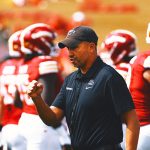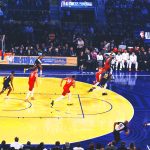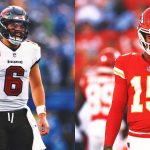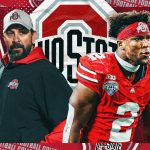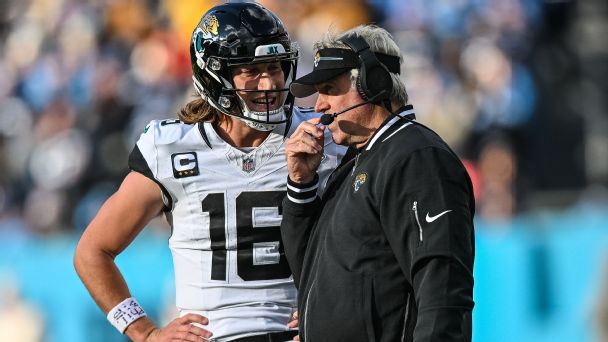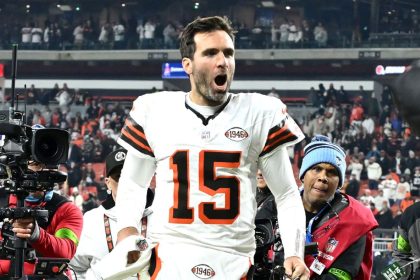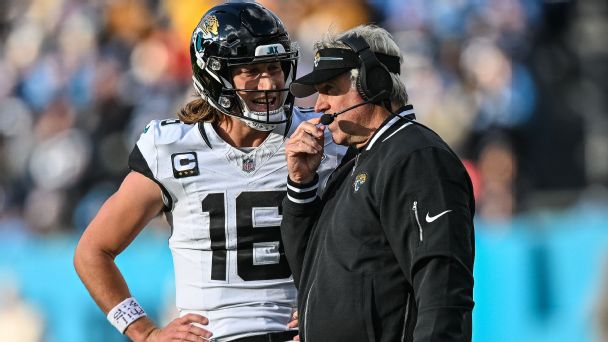
JACKSONVILLE, Fla. — Aside from the noise of showers flowing and equipment staff cleaning up, and the low rumble of huddled conversations between players, it was pretty quiet in the Jacksonville Jaguars‘ locker room after their season-ending loss at the Tennessee Titans on Jan. 7.
It wasn’t supposed to be like that. A victory over the 5-11 Titans was going to win them the AFC South title for the second season in a row and send them to the playoffs. But when a season collapses the way it did for the Jaguars — going from 8-3 with hopes for the AFC’s No. 1 seed to missing the playoffs — people are at a loss in trying to figure out what happened.
“It’s hard to process in this moment,” safety Andre Cisco said. “I definitely didn’t think of an outcome where we’d be going home today [out of the playoffs].”
When the Jaguars beat the Houston Texans on the road on Nov. 26 to improve to 8-3, they had a 98% chance to make the playoffs, per ESPN’s Football Power Index.
But they lost five of their final six games — with the only victory coming over the 2-15 Carolina Panthers — and now face an offseason filled with questions surrounding the quarterback, the defense, what’s needed to boost the talent level and its coaching.
How did the Jaguars miss the playoffs despite such a strong start? Let’s break down why the 2023 season played out the way it did, and what’s in store for the offseason.
Injuries
First, the Jaguars lost several key players down the stretch.
Nine starters missed a combined 42 games. That includes 22 by four offensive starters: WR Christian Kirk (five), WR Zay Jones (eight), QB Trevor Lawrence (one) and LT Cam Robinson (eight, though four were due to suspension).
That list doesn’t even include receiver/returner Jamal Agnew, who isn’t a starter but is a key offensive player and missed six games.
“Some years you have very few [injuries], some years you have quite a few,” coach Doug Pederson said. “For us this year it was quite a few, but it was the ones that guys were missing four games [after going on IR]. It disrupts a lot of things.”
The most impactful loss was Kirk, who suffered a core muscle injury on the first offensive play of the Jaguars’ Week 13 loss to Cincinnati on Dec. 4. He missed the final five games and the difference in Lawrence’s numbers without Kirk were noticeable.
In the 12 games in which Kirk played (which includes the play on which he was injured), Lawrence completed 67.4% of his passes with 12 touchdowns and seven interceptions and an off-target rate of 12.7%. After Kirk’s injury, Lawrence completed 62.1% of his passes with nine touchdowns and seven interceptions and an off-target rate of 23.7%.
Lawrence himself was banged up almost all season, suffering a sprained left knee in Week 6 against the Colts, a high right ankle sprain against the Bengals, a concussion two weeks later against the Ravens and a sprained right AC joint against the Buccaneers in Week 16.
Turnovers
Sure, injuries disrupt the offense, but so does giving the ball to the other team. The Jaguars turned the ball over 30 times this season — the fifth-highest total in the league — and finished with a minus-3 turnover differential.
It was the timing of the turnovers that really hurt, though.
The Jaguars turned the ball over five times in the red zone — only the Atlanta Falcons (6) had more. Jacksonville’s minus-4 turnover differential in the red zone was tied for the worst in the league with Atlanta, Dallas and Las Vegas. It’s partly why the Jaguars scored touchdowns on only 50% of their red zone drives.
Lawrence accounted for 21 of the turnovers (14 interceptions, seven fumbles), four more than he had last season. He threw multiple interceptions in four of his final eight starts this season after having no such games in his first eight starts.
Were there contributing factors to Lawrence’s struggles? Sure, his multiple injuries — as well as the injuries to Kirk and Jones, two of his most trusted targets — likely played a part. But there were also communication issues between him and the receivers, most notably rookie Parker Washington and Calvin Ridley.
Offensive coordinator Press Taylor said there’s no excuse for Lawrence or anyone else on offense.
“The turnovers are unacceptable,” he said. “We’ve probably spent more time in our two years here than I’ve ever spent as a staff talking about it with the players so they understand that. We start every Thursday with talking about turnovers and protecting the football and stats correlated with wins and losses and turnover margin and giveaways as an offense. We start our day with our turnover circuit, we continue to show clips — good examples, bad examples — how we can learn from things. It’s something that’s on our mind, but it’s something that’s got to show up in the game.”
The Jaguars allowed the fourth-most points off turnovers in the NFL with 92 — more than double that of eventual AFC South-winner Houston (38).
Offensive line play
The offensive line was one of the worst in the league, ranking 28th in pass block win rate (50.6%) and 24th in run block win rate (68.1%). Only two players ranked higher than 40th at their respective positions in pass block win rate: right guard Brandon Scherff was 14th at 93.6%, and center Luke Fortner ranked 31st at 87.9%.
But the most alarming stat? The Jaguars had the second-most runs in the league that went for no gain or a loss (120), and a league-high 26.5% of their rushes either gained 0 yards or lost yardage.
Lead back Travis Etienne Jr. averaged 3.7 yards per rush, which ranked 35th.
The Jaguars did have some flux at left tackle. With Robinson missing a total of eight games, Walker Little started seven games there (and dealt with a hamstring injury) and guard Ezra Cleveland — acquired in a midseason trade with Minnesota — started one as well.
In addition to Cleveland, three other players started at left guard, including Little. But Fortner, Scherff and right tackle Anton Harrison started every game.
Defensive struggles
On the other side of the ball, the Jaguars were one of the worst tackling teams in the NFL. Their 126 missed tackles were the fourth-most in the league, per Pro Football Reference, and a significant increase from 2022 (82). Linebacker Foyesade Oluokun had 22, tied for the NFL’s most with Detroit’s Alex Anzalone and the New York Giants’ Micah McFadden.
Outside linebackers Josh Allen (17.5) and Travon Walker (10) combined for 27.5 sacks, but the rest of the defense managed 12.5. Only seven teams had fewer than the Jaguars’ 40 sacks, none of which made the playoffs.
And while the defense did force 27 turnovers, the Jaguars went 1-3 when they didn’t have one. They forced 20 turnovers in their 8-3 start but just seven over the final six games.
Players said throughout the season there were numerous times they were undisciplined in their run fits and missed assignments. The most glaring example of the defensive breakdowns came against Cleveland.
The Jaguars didn’t cover tight end David Njoku on a third-and-1 play, leaving him wide open for a 34-yard touchdown. Then they failed to cover him on a second-and-5 play, and he was again wide open for a 30-yard touchdown. The Jaguars lost 31-27.
There also were a few minor sideline disagreements among players and assistant coaches, inconsistent practices, some major communication issues and at times a disconnect between expectations and execution.
“I’ve been thinking about it since [the slide] started,” Cisco said. “I can’t say I know why, but I would say it’s a mindset thing and it’s an approach. I think there were times when practice was good and there were times where you approached the game the right way, but not enough collectively, and it kind of showed every time on game day.”
The defensive unit failed to make significant improvement in its second season under coordinator Mike Caldwell. And Pederson felt he had to make changes on that side of the ball two days after the season ended, firing Caldwell and seven assistants (defensive line coach Brentson Buckner, inside linebackers coach Tony Gilbert, safeties coach Cody Grimm, passing game coordinator/cornerbacks coach Deshea Townsend, senior defensive analyst Bob Sutton, and defensive quality control coaches Sean Cullina and Tee Mitchell).
A defense that Pederson had said numerous times kept the team in games for the first half of the season faltered down the stretch, giving up 29.2 points per game in their five losses. Quarterbacks Jake Browning, Joe Flacco and Baker Mayfield all had more than 280 passing yards against the Jaguars.
And in the season finale — a win-and-in matchup — the Jaguars were continually out of position in the run game and allowed Derrick Henry to run for a season-high 153 yards, his most since running for 219 against Houston on Oct. 30, 2022.
Coaching
At his end-of-season news conference, Pederson talked about issues with the team’s preparation, most notably not efficiently correcting mistakes made in practice or meetings. The inability to get players to stop making the same mistakes week after week — coverage busts, poor communication, unforced errors such as turnovers and pre-snap penalties — all fall on the shoulders of the coaching staff.
“I think you get down the road during the season and as coaches, sometimes we say, ‘You know what? We’ll get to that [in a] meeting. We’ll fix that in the meeting,'” Pederson said. “You do, you fix it, but I want to fix it on the field. … I think sometimes we get caught up too much. Let’s fix it in the meeting, let’s fix it tomorrow, when in reality, we need to fix it right then. That’s just ownership by everybody involved and making sure that we stay on top of those situations. We don’t let them happen.”
Taylor was heavily criticized this season for his playcalling, but Pederson defended Taylor, saying the struggles with running the ball, turnovers, penalties and injuries that forced inexperienced players into larger roles are hard for any playcaller to overcome.
“I thought it went well,” Pederson said of Taylor’s first season as a full-time playcaller. “Can it be better? Yeah, it can be better. When you struggle offensively like we did at times, I don’t care who is calling plays. You might as well look at that thing [the play sheet] with your eyes closed and just pick a play because it’s hard. I’ve been there. You’re trying to find that one play or a spark that gets your offense rolling.
“… It’s not playcalling. It’s not the scheme or the design of plays. It’s just having the urgency of, ‘We have to protect the football better.’ Things of that nature.”
And while Pederson didn’t say it, it’s clear that the playcalling was impacted by the team’s offensive line issues, as evidenced by the two passing-play calls from the Titans’ 1-yard line late in the fourth quarter of that Week 18 game while trailing by eight points.
On third down, Taylor called a rollout pass to the right (Lawrence threw the ball away because no one was open). On fourth down, the play was an outside run to the right, but Lawrence ad-libbed and tried to stretch the ball over the goal line. He came up short — but even if the Jaguars had run the play that was called there, there would have been problems because Fortner was knocked backward at the snap.
Overall, the offense took a step back in 2023. Scoring per game was down almost a point and rushing was down 28 yards per game (479 over the course of the season) from 2022. Third-down and fourth-down conversion rates, as well as red zone production, also dipped from last season.
And when it was all said and done, the Jaguars averaged 16.4 points per game in their final four games.
“When we needed to be our best, we weren’t,” Lawrence said. “… You just have to bring that every week and there was a disconnect somewhere. Obviously, we weren’t able to put that on the field in the back half of the season like we needed to, to give ourselves a chance to make the playoffs and go on a run.”
Despite that, Pederson didn’t feel the need to make major changes to his offensive staff, firing only running backs coach Bernie Parmalee and not renewing the contract of assistant offensive line coach Todd Washington.
What’s next?
The Jaguars have a long to-do list this offseason:
-
Find a new defensive coordinator.
-
Ensure that Allen doesn’t go anywhere, either by using the franchise tag on him or signing him to a contract extension.
-
Figure out whether they want to bring receiver Ridley back, either with a new contract or by using the franchise tag if they don’t use it on Allen.
-
Make determinations on several veteran players who did not play at a high level and have high cap hits in 2024, including Scherff ($23.97 million), safety Rayshawn Jenkins ($12.3 million) and defensive tackle Folorunso Fatukasi ($12.8 million). Depending on whether the Jaguars designate one or two of those players as a post-June 1 cut, they could have as much as $40 million in cap space.
-
Fix the interior of the offensive line, whether in free agency, the draft or a combination of both. Other areas that need to be addressed are cornerback, interior defensive line, edge rushing and receiver depth.
That’s not a complete list, because there are still the disconnect that Cisco and Lawrence mentioned and the preparation issues that Pederson talked about that also must be addressed once the full staff is in place. And it’s really those things that may be the most important for Pederson and GM Trent Baalke to correct before the 2024 season kicks off.
“I think [the way this season ended] is fuel and motivation for how we move forward,” Pederson said. “[Week 18’s] three hours was kind of that snapshot of how our season has gone, especially the last six games. It has to fuel everybody’s desire to want to win and to be great. You just can’t let your preparation slip as we talked about. You can’t let a rep in practice go by without making sure it’s done properly.
“That’s me, that’s all the coaches, all the players. It’s everybody, all together, making sure that doesn’t happen.”

